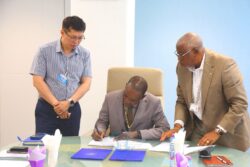A US$10million National Aquaculture Centre and Commercial Farms facility has been inaugurated to augment domestic production and reduce fish imports.
The Centre is expected to provide training and start-up support to 300 aquaculture entrepreneurs, as well as produce 50,000 metric tonnes of fish within five years.
The farmwhich operates under the auspices of the Ministry of Fisheries and Aquaculture Development (MoFAD) at the Diary Farms in Amrahia, and comprises facilities such as aquaculture indoor structures, classrooms, student and staff accommodation, mechanic’s workshop, packaging warehouses and a cold storage facility for chemicals and inputs, a water reservoir and power station among others.
Sector minister Mavis Hawa Koomson said the Centre will utilise state-of-the-art technology to increase total annual fish production from the aquaculture subsector.
“Due to the peak in harvest from wild fisheries, aquaculture is widely recognised as an effective way to meet the seafood demands of a growing population,” she said.
The facility is expected to increase employment opportunities for farmers through modernised agriculture in the aquaculture industry, engage youth graduates and women in aquaculture, improve income security and reduce poverty in the project areas.
With over 600,000 metric tonnes of fish imported into Ghana every year, the country’s annual catch is estimated to be less than 400,000 metric tonnes. Aquaculture has therefore been identified as the means to bridge this gap and achieve the fisheries transformation agenda.
Aquaculture is one of the fastest-growing forms of fish production in Ghana, as approximately 90 percent of the practice is focused on freshwater farming of catfish and tilapia.
Conversely, marine aquaculture – which refers to the cultivation of oceanic species such as oysters, clams, mussels, shrimps, salmon and algae – is unpopular due to lack investment in skills, finance and technology.
As the country’s marine stocks continuously face threats of depletion, MoFAD has in recent years been implementing strategies to curb the phenomenon.
Ghana, currently imports over 60 percent of its fish. The MoFAD attributed these high imports to the country’s depleting stocks and the need to urgently address it.
Meanwhile, IUU fishing – the single largest bane accosting the fisheries sector according to the Environmental Justice Foundation (EJF) – deprives the country of more than US$80million annually.
The fishing industry in Ghana brings over US$500million into the economy every year and employs over 3 million people in the value chain, according to the EJF.










